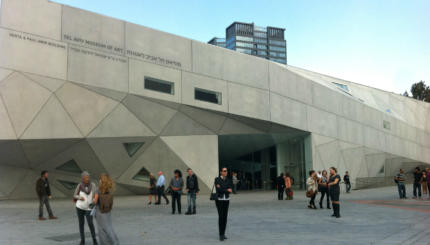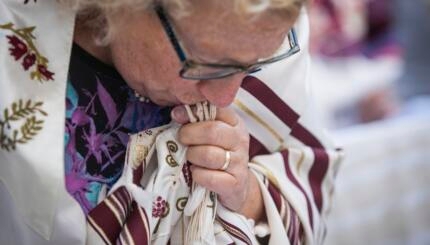Jewish art tends to be associated with European painters like Chagall, Liebermann, Pissarro, and Soutine. But Bombay-born painter Siona Benjamin, whose art combines Jewish, Indian, and American elements, shatters the misconception that Jewish art is essentially Western.
A Shipwrecked Ancestry, a Rootless Identity
The history of Benjamin’s ancestors, the Bene Israel Jews of India, has been disputed. Legend has it that they were shipwrecked in India, either fleeing the Assyrians in the eighth century B.C.E. or Antiochus IV Epiphanes 600 years later. According to one version of the story, most of the refugees drowned, but a few swam to safety, where the local non-Jewish population welcomed them. The survivors, who lost their holy books at sea, remembered just the prayer. Cut off from extra-biblical writings and Jewish customs, this community borrowed traditions from the native culture.
Much like the stories about the Bene Israel, Benjamin’s life has featured a great deal of cross-cultural exchange. Born in 1961, she grew up in a largely Hindu and Islamic culture, and received her education as a child at Catholic and Zoroastrian schools. She was trained in fine arts in Bombay and Illinois, and married a Connecticut native–a man who was raised Russian Orthodox, has Judaism as part of his “family mix,” became a Buddhist in the 1970s, and studied Indian classical music in California. She lives with him in New Jersey.
Given her past, it is not surprising that Benjamin has called the anxiety of finding home, both spiritually and physically, the perpetual preoccupation of her life and career. But she has also described her “rootless” heritage as “seductive,” and indeed her unique story has informed her large body of critically-acclaimed works.

Help us keep Jewish knowledge accessible to millions of people around the world.
Your donation to My Jewish Learning fuels endless journeys of Jewish discovery. With your help, My Jewish Learning can continue to provide nonstop opportunities for learning, connection and growth.
Benjamin’s work has appeared in more than 30 solo shows and more than 60 group shows. She has been reviewed in major U.S. dailies and in Indian-American publications, and has been featured in scholarly articles and books by Jewish art historians Ori Soltes and Matthew Baigell.

Delicious “Miniature-Inspired” Paintings
Benjamin’s art is always eclectic, including images, Byzantine icons, and styles derived from Jewish and Christian illuminated manuscripts, all blended with contemporary Pop Art imagery. She combines these diverse elements in very small paintings, following the technique of Indian/Persian miniatures.
Largely developed between the 14th and 19th centuries, Indian and Persian miniatures are illuminations on paper, generally two to four inches in size. According to miniature painter Ambreen Butt, who taught at Massachusetts College of Art and studied miniature painting in her native Lahore, Pakistan, Benjamin’s works are “miniature inspired” but not technically miniatures, since they do not use traditional materials.
Butt uses the word “masala” (a blend of spices) to refer to the collage of diverse elements in Benjamin’s work. “That’s what I’d call her paintings,” Butt says, “delicious food.”
“Blue Like Me”
The flavorful blend of elements is apparent in Benjamin’s “Finding Home No. 56 (‘Zakhm’).” This painting shows a sleeping blue-skinned (like the god Krishna) woman in a forest. Two angels and 10 gold scimitars hover above the figure and flank a green circle with the Hebrew word “Shema” (Deuteronomy 6:4, the prayer the Bene Israel remembered), surrounded by elaborate floral patterns. Benjamin also embedded text which seems to be Arabic, but in fact is the English phrase, “It’s unfortunate.”
The blue woman is a self-portrait, and the blue skin symbolizes Benjamin’s alienation as a Jewish woman of color, the artist has explained. In her essay “Blue Like Me,” published in the recent book From Word to Canvas: Appropriations of Myth in Women’s Aesthetic Production, Benjamin reflects on this alienation, and says that she has come to the conclusion that there is no perfect “place” or “home,” either for herself or for anyone. She believes her “nonbelonging” allows her to create a temporary home-like abode and “also to celebrate in art the impossibility of fixedness in any single ‘home.'”
It is not clear what exactly is unfortunate about “Zakhm” (which means wound in Hindi). The vulnerable figure seems to be unaware of the scimitars, and perhaps the weapons are harbingers of unfortunate circumstances.
“Finding Home No. 74 (Fereshteh) ‘Lilith,'” from Benjamin’s Fereshteh (“angels” in Urdu) series, shows another blue-skinned woman. This time she is named Lilith (in Hebrew, at the bottom of the painting)–who is, in Jewish folklore, the queen of the demons. In the painting, Lilith wears a (prayer shawl), and declares (via cartoon bubble), “A thousand of years have I waited keeping the embers of revenge glowing in my heart!”
Burning embers (which look rose-like) burn behind Lilith, and the hamsa (which is a Jewish and Islamic symbol) makes an appearance in her necklace. Around her arm is a snake-shaped band (serpents symbolize rebirth in Hindu and Buddhist thought), and she has a bullet wound on her chest, which Benjamin has said resembles Saint Theresa’s stigmata (the saint’s experience of divinely-inflicted pain which correspond to Jesus’ wounds on the cross). Benjamin says that her figure represents not only the character of Jewish lore, but also “the woman targeted, the sacrificing mother, the mourning war victim, the brave woman soldier, the rape victim in war.”
Siona Benjamin’s work brings together a wide array of sacred and secular images: Lilith, the Pop artist Roy Lichtenstein, Indian comic books, lotus flowers, American flags, ballerinas, tanks, IV needles, phylacteries, gas masks. But she does more than just collage American, Jewish, and Indian symbols together. She also rethinks the context and symbolism of those references. 
For example, in “Finding Home No. 46 (‘Tikkun ha-Olam’)” Benjamin shows a self-portrait of the artist as a seven-branch Menorah, no doubt a Jewish play on the multi-armed Hindu gods. The candleholders are hamsas, and the figure dances beside a snake (the evil inclination?) and a sphinx blowing a horn (shofar?). In casting herself as Shiva–a major Hindu God–Benjamin achieves the same sort of religious nuance that Chagall attains in his “White Crucifixion” (1938), where Jesus’ loincloth is a tallit. By stressing Jesus’ Jewishness, Chagall shows that Jews can “own” the symbol of the crucifixion and it need not only appear in Christian contexts. Benjamin’s Jewish Shiva blends the imagery of the menorah’s arms (representing the days of creation) with the symbolism of Shiva’s arms (which also may have to do with creation).
In so doing, Benjamin is perhaps also presenting the artistic version of the talmudic declaration that there are 70 perspectives (literally panim, or faces) to the Torah. By presenting her personal Jewish identity, Benjamin exposes some of the Western stereotypes about Judaism and reminds her viewers that just as there are 70 equally valid interpretations of the Torah, there are dozens of ways to make a Jewish painting. The rabbis did not necessarily have Benjamin’s interfaith enterprise in mind, but just as Jewish art has so often borrowed aesthetic forms from Christian and pagan culture, Benjamin establishes herself as heir to that tradition and adds her own personal touch by using contemporary symbols and references.
Images courtesy of Siona Benjamin.


